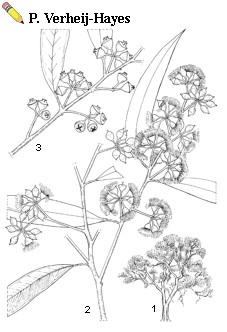Record Number
3501
PROSEA Handbook Number
5(1): Timber trees; Major commercial timbers
Taxon
Eucalyptus camaldulensis Dehnh.
This article should be read together with the article on the genus: Eucalyptus in the Handbook volume indicated above in this database.
This article should be read together with the article on the genus: Eucalyptus in the Handbook volume indicated above in this database.
Protologue
Cat. pl. horti camald. 2nd ed.: 6, 20 (1832).
Synonyms
Eucalyptus rostrata Schlechtendal (1847).
Vernacular Names
River red gum, red gum (En).
Distribution
Native to most parts of Australia. Cultivated throughout Malesia and in many tropical and subtropical parts of the world.
Uses
Because of its great strength and good durability the wood is suitable for many structural applications, even in situations of high hazard, e.g. for railway sleepers, poles, posts, flooring, wharfs, ship building and heavy construction. But above all it is used for firewood and pulp production. Eucalyptus camaldulensis is sometimes planted as a reforestation tree. It produces a good-quality charcoal. The bole yields kino which can be used as a dye. The flowers produce a first grade honey.
Observations
A small to medium-sized, sometimes large tree of up to 20(-45) m tall, bole often rather crooked, bark smooth, white, grey, brown or red; juvenile leaves alternate, ovate to broadly lanceolate, petiolate, adult leaves alternate, lanceolate to narrowly lanceolate, slightly discolorous, 8-30 cm 0.7-2 cm, acuminate, green or grey-green, petiole 12-15 mm long; inflorescence axillary, solitary, 7-11-flowered; flower buds globular-rostrate or ovoid-conical, operculum hemispherical, rostrate or conical, 4-6 mm 3-6 mm, obtuse; fruit hemispherical or ovoid, 5-8 mm 5-8 mm with 3-5 exserted valves. Eucalyptus camaldulensis is the most widespread eucalypt of Australia and occurs mainly along watercourses up to 600 m altitude. There is considerable morphological variation within the species, which is not surprising given its wide geographic distribution. The density of the wood is 900-980 kg/m3 at 12% moisture content. See also the table on wood properties.
Image
 | Eucalyptus camaldulensis Dehnh. - 1, habit; 2, flowering branch; 3, fruiting branch |
Selected Sources
[63a]Boland, D.J. et al., 1984. Forest trees of Australia. Industrial Research Organisation, Melbourne. 687 pp.
[66]Bolza, E. & Kloot, N.H., 1963. The mechanical properties of 174 Australian timbers. Technological Paper No 25. Division of Forest Products, CSIRO, Melbourne. 112 pp.
[130]Chew, T.K., 1980. Growth of Eucalyptus species in Peninsular Malaysia. Malaysian Forester 43: 8–15.
[202]Eldridge, K.G., 1975. Eucalyptus camaldulensis. Tropical Forestry Papers No 8. CSIRO, Division of Forest Research, Canberra. 59 pp.
[232]Flora of Australia (various editors), 1981–. Australian Government Publishing Service, Canberra.
[322a]Hillis, W.E. & Brown, A.G., 1978. Eucalypts for wood production. Griffin Press, Adelaide. 434 pp.
[343]Jacobs, M.R., 1981. Eucalypts for planting, 2nd ed. FAO Forestry Series No 11. FAO, Rome. 677 pp.
[362]Kingston, R.S.T. & Risdon, C.J.E., 1961. Shrinkage and density of Australian and other South-West Pacific woods. Technological Paper No 13. Division of Forest Products, CSIRO, Melbourne. 65 pp.
[540]Penfold, A.R. & Willis, J.L., 1961. The eucalypts: botany, cultivation, chemistry and utilisation. Hill, London. 551 pp.
[66]Bolza, E. & Kloot, N.H., 1963. The mechanical properties of 174 Australian timbers. Technological Paper No 25. Division of Forest Products, CSIRO, Melbourne. 112 pp.
[130]Chew, T.K., 1980. Growth of Eucalyptus species in Peninsular Malaysia. Malaysian Forester 43: 8–15.
[202]Eldridge, K.G., 1975. Eucalyptus camaldulensis. Tropical Forestry Papers No 8. CSIRO, Division of Forest Research, Canberra. 59 pp.
[232]Flora of Australia (various editors), 1981–. Australian Government Publishing Service, Canberra.
[322a]Hillis, W.E. & Brown, A.G., 1978. Eucalypts for wood production. Griffin Press, Adelaide. 434 pp.
[343]Jacobs, M.R., 1981. Eucalypts for planting, 2nd ed. FAO Forestry Series No 11. FAO, Rome. 677 pp.
[362]Kingston, R.S.T. & Risdon, C.J.E., 1961. Shrinkage and density of Australian and other South-West Pacific woods. Technological Paper No 13. Division of Forest Products, CSIRO, Melbourne. 65 pp.
[540]Penfold, A.R. & Willis, J.L., 1961. The eucalypts: botany, cultivation, chemistry and utilisation. Hill, London. 551 pp.
Author(s)
C.C.H. Jongkind
Correct Citation of this Article
Jongkind, C.C.H., 1993. Eucalyptus camaldulensis Dehnh.. In: Soerianegara, I. and Lemmens, R.H.M.J. (Editors): Plant Resources of South-East Asia No 5(1): Timber trees; Major commercial timbers. PROSEA Foundation, Bogor, Indonesia. Database record: prota4u.org/prosea

All texts are licensed under a Creative Commons Attribution-Noncommercial-Share Alike 3.0 Netherlands License
This license does not include the illustrations (Maps,drawings,pictures); these remain all under copyright.